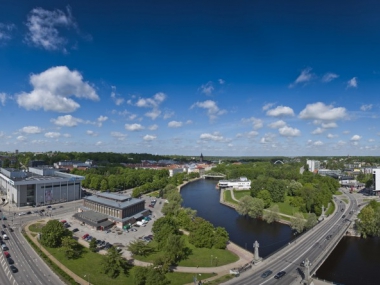Tartu uses various interactive methods to involve citizens
Edited on
02 October 2018Tartu is a partner in the Interactive Cities project and a university town in Estonia with around 100 thousand residents. It has developed into an inspiring environment for IT communities that have found in Tartu an opportunity to combine a pleasant living environment with exciting professional challenges. However, the city government wants to help school and university students in Tartu to see more of the city’s potential and to motivate them to have a say in issues concerning life in the city and to keep living and working in the city in the future.

Getting more young people involved in participative budgeting processes
Tartu wants to offer its residents a living environment where everyone is aware of the local opportunities and wants to contribute to the regeneration of the city. The participative budget, which is being used for the fifth year in a row, is one way of doing this. A very brief description would be that a participative budget allows citizens to offer ideas on what could be done in the city and to select winning ideas once a year. The two ideas that receive the most votes from residents are implemented by the city government. Citizens can submit their ideas, comment on them and vote in the online VOLIS environment, which can be accessed with the ID card that is widely used in Estonia.
To date, activities introducing the participative budget have been aimed at all citizens at the same time, but the goal chosen by Tartu within the scope of the IC project is to invite young people to participate more in submitting ideas for the budget and voting. The main reasons why young people take so little interest in the local living environment (with around just 3% of those who voted in the participative budget being aged 16-19) were identified at the meeting with the target group held in January. Why are young people so passive? The young people themselves said that anything related to politics and the public sector seems to be an “adult thing”, complicated and boring/uninteresting. They don’t feel that the ideas they would submit would find many supporters. So the main issue is presupposition, not any substantive problems or obstacles.
We have launched some substantive activities in addition to the preparation of an action plan. For example, young people themselves will make a video introducing the participative budget, where the protagonist is a well-known local stand-up comedian chosen by the young people themselves. The video will be distributed in various interactive channels, of course by the young people themselves.
Idea collection map
The participative budget is not the only way of offering ideas on how to make life in the city better. The publication of the general plan of the City of Tartu begins in April and citizens are invited to share their proposals and ideas about the plan. An idea collection map is to be tested for the first time within the scope of the general plan’s preparation. This is a crowdsourcing solution which is used in many places around the world, giving people the chance to note their ideas or problems on a map. We look forward to receiving ideas about major investments as well as minor improvements. Idea collection represents vision mapping, not a specific planning or financing tool.
Proposals are added to the general plan document and the city government makes the final decision about their implementation. The solution has garnered around 80 ideas in less than a couple of weeks, the majority of them practical ones – people would like to see cycle paths, dog walking grounds and playgrounds for children. However, there are also ideas that look further into the future, e.g. the establishment of a school in a city district or houseboat infrastructure on the Emajõgi River.
We view the idea collection map as a logical step in complementing the participative budgeting. During the budgeting process many interesting suggestions have been made, but they are often too big or too expensive (or have too limited appeal) to fit into the framework of participative budgeting. The idea collection map will be a useful way of collecting input for the city government, and hopefully it will be used in the near future on a more regular basis.
Submitted by fvirgilio on
